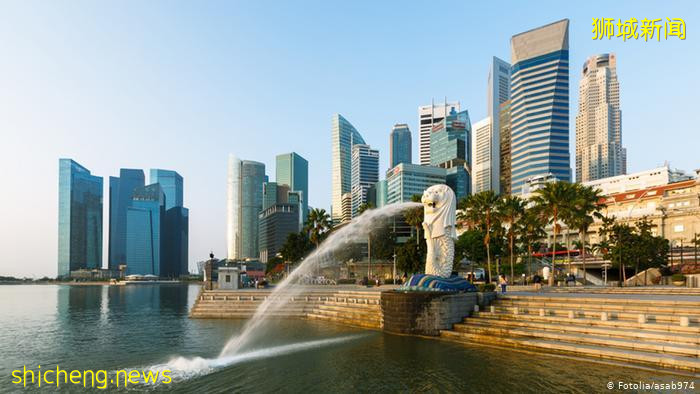
Singapore is a tiny country, so tiny you can drive across the island in just an hour. Despite its size and lack of natural resources, Singapore’s 5.6 million people enjoy one of the highest average incomes in the world, ahead of countries like Germany, France, and Japan.
新加坡是一个很小的国家,小到你可以在一个小时内驾车穿越整个岛屿。尽管面积很小且缺乏自然资源,新加坡的560万人仍是世界上平均收入最高的国家之一,领先于德国,法国和日本等国家。
So, how did this little island get so rich?
那么,这个小岛怎么变得如此富有呢?
Singapore doesn’t have resources like coal or oil but it does have something countries can’t buy, location. The island sits in the middle of an important trade route connecting Asia to Europe. That’s a key reason why the British decided, back in 1819, to set up a colony in Singapore. Location isn’t everything though.
新加坡没有像煤炭或石油这样的资源,但是它有一些国家无法购买的东西,地理位置。该岛位于连接亚洲与欧洲的重要贸易路线的中间。这就是英国人在1819年决定在新加坡建立殖民地的关键原因。位置并不是全部。
There are several countries nearby that could have made use of their whereabouts, but they weren’t quite as successful. That’s because other ingredients go into this crazy rich Singapore recipe.
附近有几个国家可以利用他们的下落,但是他们并没有那么成功。那是因为在这个疯狂而丰富的新加坡成功秘籍中还有其他成分。
I’m at the Raffles Hotel, which is one of the most prominent icons of Singapore’s colonial history. Unlike some of its neighbors, which wanted to separate themselves from their colonial histories, Singapore kept close ties with Britain, even after independence in 1965.
我现在在莱佛士酒店,这是新加坡殖民历史上最杰出的标志之一。与一些邻国希望将自己与殖民地历史分开的新加坡不同,即使在1965年独立后,新加坡仍与英国保持着紧密联系。
That decision announced to the rest of the world that Singapore was open for business. That’s important because we know now that exports help to grow and expand an economy. But back then, it wasn’t conventional wisdom.
该决定向世界其他地方宣布,新加坡开始开放。这很重要,因为我们现在知道出口有助于增长和扩展经济。但是那时候,这不是传统的看法。
Singapore, Hong Kong, Taiwan, and South Korea, became known as the four Asian tigers, which have grown rapidly since the 1960s. Their rise was fueled by exports, industrialization, and more crucially, big doses of government intervention. This was especially true for Singapore.
新加坡,香港,台湾和韩国被称为四只亚洲虎,自1960年代以来迅速发展。出口,工业化以及更重要的是政府的大量干预助长了它们的崛起。对于新加坡尤其如此。
Labor strikes were common on the island in the 1960s, even with high unemployment. On top of that, there was a housing crisis, with Singapore being home to one of the largest slum settlements in the world.
即使失业率很高,在岛上工人罢工在1960年代也很普遍。最重要的是,发生了住房危机,新加坡是世界上最大的贫民窟之一。
So how do you build a more disciplined labor force to attract investment?
那么,如何建立一支纪律严明的劳动力队伍来吸引投资呢?
Well, you give them something to work for, like a house of their own, which is why one of the first Singapore government agencies set up was focused on building affordable public housing. While just nine percent of the population lived in public housing in the 1960s, that figure stands at more than 80 percent today, add in greater employer rights and strikes became extremely rare.
好吧,给他们提供了一些可以工作的东西,例如拥有自己的房屋,这就是为什么新加坡最早成立的政府机构之一专注于建造负担得起的公共住房。尽管在1960年代只有9%的人口居住在公共住房中,但如今这一数字已超过80%,但增加了雇主权利,罢工变得极为罕见。
At the same time, the government attracted foreign investment through tax incentives, growing the economy and easing unemployment, which fell from an estimated 14 percent in 1959 to 4.5 percent in the 1970s.
By the 1980s, Singapore was a regional manufacturing hub, and it was the world’s biggest producer of hard disk drives. But today, manufacturing makes up only about 20 percent of Singapore’s GDP.
同时,政府通过税收激励措施吸引了外国投资,促进了经济增长并缓解了失业率,失业率从1959年的14%降至1970年代的4.5%。到1980年代,新加坡已成为地区制造中心,并且是世界上最大的硬盘驱动器生产国。但是今天,制造业仅占新加坡GDP的20%。
Take a look at Singapore’s growth in GDP, you can see two big surges, one beginning in the late 80s and another at the start of the new millennium. Ironically, Singapore has a downturn to thank for that. You see, in 1985, Singapore went into its first post-independence recession, prompting the government to introduce new measures. State-owned companies like telecommunications were privatized to make them more competitive.
看看新加坡的GDP增长,您会看到两次大幅增长,一次是在80年代末开始,另一次是在新千年之初。具有讽刺意味的是,新加坡对此表示感谢。您会看到,1985年,新加坡进入了第一次独立后的衰退,促使新加坡政府采取了新措施。电信等国有公司被私有化,以使其更具竞争力。
Then at the turn of the century, service industries like finance and insurance were further liberalized. That openness helped to grow the share of services from just 24 percent of GDP in 1985 to more than 70 percent in 2017.
然后在世纪之交,金融和保险等服务业进一步开放。开放性使服务的份额从1985年的GDP的24%增长到2017年的70%以上。
Multinational companies began to set up regional headquarters in Singapore. That attracted even bigger players, boosting Singapore’s attractiveness to corporates and in turn its GDP.
跨国公司开始在新加坡设立地区总部。这吸引了更大的参与者,从而提高了新加坡对企业的吸引力,进而提高了其国内生产总值。现在,新加坡已被列为世界上最容易经商的地方之一。
Now, Singapore is ranked as one of the world’s easiest places to do business. Singapore has been praised for transforming itself from a developing to a developed economy.
新加坡因从发展中经济体向发达经济体转型而受到赞誉。
But do most Singaporeans feel rich? Well, not exactly.
但是,大多数新加坡人感到有钱吗?好吧,不完全是。
Two of the most important reasons? The high cost of living and inequality. For five years in a row, Singapore has been named the world’s most expensive city, ahead of New York and London. That’s largely because of taxes on cars, making Singapore the most expensive place in the world to buy and run an automobile. It’s also the third most expensive place on Earth to buy clothes.
两个最重要的原因?高昂的生活成本和不平等。新加坡已经连续五年被评为全球最昂贵的城市,超过纽约和伦敦。这主要是因为汽车税,使新加坡成为世界上购买和运行汽车的最昂贵的地方。它也是地球上购买衣服的第三贵的地方。
But personal care, household goods, and domestic help in Singapore tend to be less expensive than in other major cities.
但是在新加坡,个人护理,家庭用品和家政服务的价格往往比其他主要城市便宜。
While Singapore is rich in terms of GDP per capita, the median monthly salary is $3,270. That doesn’t sound too bad, but about 20 percent of that goes into a mandatory savings account. You can use that account to pay for medical bills, housing, and education, but it does restrict the purchasing power of the population.
新加坡的人均GDP很高,月薪中位数为3,270新币。听起来还不错,但是其中约有20%存入了强制性储蓄账户。您可以使用该账户支付医疗账单,住房和教育费用,但这确实限制了人们的购买力。
You’ve probably heard of the movie Crazy Rich Asians, which was set here in Singapore. And it’s no wonder. Because Singapore has about 184,000 millionaires, making it truly the land of the crazy rich. That’s great news.
你可能听说过在新加坡拍摄的电影《疯狂的亚洲富人》。这也就不足为奇了。因为新加坡有大约184,000名百万富翁,所以它确实是疯狂富人的土地。这真是个好消息。
But Singapore also has a fairly high rate of inequality, compared with other developed countries. Let’s look at the Gini coefficient, which is a scale used to calculate inequality, with zero being the most equal and one being the least.
但是与其他发达国家相比,新加坡的不平等率也很高。让我们看一下基尼系数,它是用于计算不平等程度的标度,其中0等于最大,而1等于最小。
Singapore’s Gini coefficient, after accounting for taxes and transfers, was 0.356 in 2017. That was worse than countries like the United Kingdom, Japan, Korea, and Germany, although it fared better than some, like the United States.
在计入税收和转移支付后,新加坡的基尼系数在2017年为0.356。这比英国,日本,韩国和德国等国家差,尽管表现要好于美国等国家。
Is that number that bad? That question had books like this flying off the shelves. A think tank ignited a public debate on the divide in social classes, after it found that on average, Singaporeans who live in public housing have fewer than one friend who lives in private housing. The government has called the issue of inequality a national priority, but it remains to be seen if it is a problem that can be tackled effectively.
这个数字真的那么糟糕吗?一个智囊团点燃了公众对社会阶层分化的争论,居住在组屋中的新加坡人拥有少于一个居住在私人公寓中的朋友。政府已将不平等问题称为国家优先事项,但是否能够有效解决这一问题尚待观察。